

[ Metro | Metroactive Central | Archives ]
Roundabout Looks
Jackie Chan had it done. So have some of your friends. As upper eyelid surgery gains converts in the Asian-American community, is it a desire to look better or assimilation gone mad?
ONE SUMMER DAY in 1990, "Jennifer"--a Korean-American who was then a 21-year-old San Jose State student--walked into a San Jose plastic surgeon's office. He came highly recommended by her mother's friends. His specialty: creating superior palpebral folds to the eyelid, a.k.a. "double eyes," a characteristic absent from 50 percent of Asians and 75 percent of Koreans. She sat down, flipped through dog-eared copies of Allure and Vogue, and waited for her name to be called.
The door creaked open, and she made her way into the operating room. The doctor administered three shots of local anesthetic around each eye. As the surgery progressed, complications arose, and a routine hour-long surgery stretched into two hours.
Looking at her reflection afterward, Jennifer didn't resemble anything like the models posing in the waiting-room magazines. She looked beaten up. Her eyes were swollen and bruised. Without any medication, she drove home by herself, with the advice to take it easy for a week.
When the swelling eventually disappeared, so did Jennifer's apprehension. The bright marketing assistant of a local desktop publishing firm now says the surgery was worth every incision. There's no question where eye shadow goes, and attention from men, she says, has increased. As she sips her latte at the Moulin Rouge coffeehouse, she talks confidently about her post-operative experiences, poking holes in theories about occidentalization--the "selling out" to western ideals of beauty. This self-assured woman with cashew-shaped eyelids makes it clear: the one thing a scalpel couldn't remove from her body is regret.
"I spoke to my co-workers and they don't understand," Jennifer said. "They think it's faking. I told them, if you think this is faking, why do you cut your hair? Why do you get perms? Why do you wear makeup? Earrings make a hole in part of your body. To me, it's not that different."
THE EYES, the saying goes, are the windows of the soul. It's the first thing you notice about a person. You can tell if someone is lying or lecherous--or both--with a swift glance. Asians, faced with doubts about the size and beauty of their eyelids, are flooding into plastic surgery offices to outfit themselves with a new pair.
The eyelid crease, a dominant genetic trait, is determined by the structure of the levator muscle, which controls the opening of the lid. While everyone--Asians and non-Asians alike--has this muscle, in non-Asians an extension of the muscle causes a crease to form when the eyes are opened. Asians do not always have this extension, but instead have an extra layer of fat. During surgery, the doctor removes the fat and stitches the eyelid to the levator muscle, creating a crease.
Figures from the American Association of Facial Plastic and Reconstructive Surgery indicate that there has been a 35 percent rise in cosmetic surgery procedures in the United States since 1990. The surgery is catching on nationwide, in image-conscious California, and especially in the Bay Area, where both Asian and plastic surgeon populations are growing every year.
In the realm of plastic surgery, where Jewish women undergo rhinoplasty and African Americans alter facial characteristics with nose jobs, lip reductions and skin lightening, it seems as if distinct ethnic features are treated as a handicap. The surgical technique to augment two flitting folds inspires debate in the Asian American community. Is it a sellout to western ideals of beauty, or is it a way to make an Asian face more, er, complete?
"I think that all females want to look better," explains Jennifer, who emigrated to the United States from Korea when she was 14 years old. "The main reason people are doing it in Korea is because they want to look pretty. When so many people do it, you don't think you're doing something wrong."
In Korea, the surgery is as common as orthodontic braces are in the United States. The surgery can cost up to $3,500 in the U.S., but only about $800 to $1,200 in Seoul. It's been estimated that 40 percent of young Korean women undergo the surgery. Many Korean women participate in a "kye"--gatherings at which each participant makes a contribution to a pool so that she may obtain a large amount of cash when her turn arrives to collect from the pool--to obtain money for the surgery.
In some places, it's hard to find someone without folds. Im Kwon-Taek, the director of Sopyonje, a popular movie set in 1950s-era Korea and released in 1993, searched desperately in Seoul for an actress with creaseless eyelids to play one of the major roles. He eventually settled on a young woman with no acting experience. Even revered action hero Jackie Chan had eyelid surgery at the suggestion of his studio, Lo Wei Films, in 1977. He was told it would improve his looks and make him more popular.
FAMILY PRESSURE often sends women into plastic surgery clinics. "Kimberley," a 22-year-old Korean-American pursuing a degree in economics at UC-Berkeley, flew to Korea and visited a doctor who specialized in s'sangkopul, or eyelid surgery, when she was just a freshman in high school. For about $200, the doctor created a superior palpebral fold across each eyelid. When she returned to school, Kimberley had two new upper eyelid folds to complement her pencil box and backpack.
"It was ultimately my decision, but it wasn't my idea," Kimberley recalled. "My aunt asked me to get it. I went to see how it was done and she said, 'Hey, you'd look better with it,' so I said, 'OK.' It's very much accepted over there."
Jennifer received similar encouragement from her mother. "It's kind of a scary thing to do," she said. "I didn't feel like doing it. I didn't have the courage to go in myself, but my mother kind of pushed me to do it. ... My mother is like my God."
"Jaclyn," a Korean American woman who plays guitar in an up-and-coming indie pop band, has found a stronger identity in resisting the cultural migration toward rounder eyes. Six people in Jaclyn's social circle have surgically enhanced eyelids, including friends, former roommates, and her mother, who altered her eyelids in the summer of 1978.
Jaclyn grew up in a predominantly white neighborhood, where the standard of beauty was not Asian. She says she responded by "acting white" and even wearing Scotch tape on her eyes overnight to emulate the fold. The pressure to cut her upper eyelids began in junior high, when her mother offered to pay for surgery when she got older.
"It was matter of fact: when you get older and graduate from high school, you'll go and have it done," she said. "I was led to believe that doing it would make me prettier and more attractive to men, and find a husband."
Jaclyn resisted the offers and resolved her conflict with her appearance and ethnicity. "I have some friends and we talk frankly. Something about it is so fake and plasticky. When someone points it out and says they're attractive, it's like, big deal, I can look just as good with plastic surgery. When I see someone who has the surgery done, they're pretty because they bought that. It's not real."
"For me it's part of my whole acceptance of myself for who I am. I happen to be a Korean woman and this is how I look, and this look is from my genetic structure and makeup, and then to find beauty in it. Whatever you want to do, that's cool. For me personally, I'm not gonna do it."
WHEN COMMODORE Perry opened Japan up to the rest of the world in 1868, Japanese folks got a glimpse of western culture and fashions, and it soon became the rage.
In 1896, Japanese surgeon K. Mikamo introduced a non-incision eyelid technique to the world, and subsequently popularized the "three-stitch technique" where upper eyelids were sutured six to eight millimeters above the eyelash with silk thread, creating a scar line that produced a fold. His technique spurred other plastic surgeons to follow his example for the next 50 years. Lieutenant Col. Burgos T. Sayoc's paper on "Plastic Construction of the Superior Palpebral Fold" won a prestigious Medal of Merit at the annual meeting of the Philippine Society in 1952.
As much as patients resist the thought, Asian eyelid surgery was born out of a desire to appear more Occidental. Eyelid surgery boomed after World War II, said Hawaiian surgeon Leabert R. Fernandez in a 1959 article, "due to the influx of Caucasians, with intermarriages." During the '60s, eyelids became an obsession. Fashion-conscious Asian American teens would go as far as to tape their eyelids to emulate the standard equipment seen on their favorite film and TV stars. Those who could afford the surgery would have it done, to the envy of their pals.
In 1963, a Malayan doctor, Khoo Boo-Chai, pushed his popular non-incision method of "Oriental Blepharoplasty," the creation of "double eyes." He believed that desire for the surgery stemmed from three reasons: socioeconomic (the western look being more accepted); local beliefs and superstition (to eradicate suspicious "mousy" eyes); and "domestic" (better chance to snag a prospective husband).
"Our Eastern sisters put on western apparel, use western makeup, see western movies, and read western literature," Khoo Boo-Chai wrote in 1963. "Nowadays, there even exists a demand for the face and especially the eyes to be westernized. This upper eyelid operation can be considered a purely cosmetic surgical procedure amongst Asians."
In the excessive '80s, plastic surgery experienced a renaissance with Cher and Michael Jackson leading the charge. During a cheeseball 1987 pro-cosmetic-surgery video called "How To Change Your Life ... Through Cosmetic Surgery," Phyllis Diller explained the history of Asian blepharoplasty while sporting a bamboo rice-picker hat, and sipping oolong from a tea set placed on a ceramic elephant table. "Cosmetic surgery crosses all lines of age and sex, but race as well," Diller croaked. "While the popularity of surgery and augmentation has grown in the U.S., it's more popular in the Orient ... " The segment, which features a rapid description of the surgery and ecstatic description of street surgeons in Japan, segues into the use of plastic surgery to combat physical deformities.
IN MOST CASES, the surgery lasts about an hour and begins with an application of local anesthesia. First, a surgeon cuts along a pre-drawn line and pulls down the skin on top of the lower skin of the incised eyelid. Fat tissue in between the layers is sucked out and the eyelid sutured. The patient returns home, and after six to seven days the stitches are removed and the patient is a proud owner of "double eyelids."
The eyelid is the most delicate skin on the human body, and like all surgeries, risks are inherent. The most commonly reported problem is asymmetry. The doctor pushes a blunt-tipped wire across the eyelid to create a margin line and then inks in the space with a marking pen. If the doctor doesn't recheck the lines periodically, uneven eyelids can result. Beginning doctors often make blunders, leaving one side higher than the other. In Korea, unlicensed doctors (called tol'pari doctors) travel to patients' houses and perform the surgery for cheap. It's no wonder a small percentage of stateside Asian eyelid surgeries are done to correct these mishaps.
Other problems reported include exaggerated folds, eyelashes pointing at different angles, eyelids that lose the fold after a couple years, unwanted extra "accessory" lines, and eyes that appear unnaturally large. Of course, there also come risks of infection, scarring and blindness. To the surgery's many detractors, the most damaging post-operative risk, beyond death, is psychological: rejection of culture.
DEBBIE THEN, a social psychologist from Stanford, specializes in beauty issues. She believes the surgery isn't about rejecting one culture for another. "I don't think they want to become more westernized," Then says. "Having more of an eyelid is more appealing for women so they can wear makeup easier.
"They don't want to stand out as much; it's a desire to fit in," she says. "I don't think it's a self-hate thing, it's a self-improvement thing. Eyes are called the window into the soul, and the more you can see them, the more they stand out, the more they tell about a person."
For Jennifer, her eyelid surgery was about fitting in, but not the way she's been accused of. "It has something to do with culture," she explains. "When I go back to Korea, everybody dresses the same. Once something is fashionable, everyone follows; that's the way of life. Over here, everyone has an independent style. Over there, if heavy makeup is popular, then everyone follows the fashion. We think of it more as a fashion thing. It's like wearing a miniskirt; if you follow the trend you do it."
But if surgically embellished eyes are supposedly prettier, then what are foldless eyelids? Dogmeat? Isn't one man's Roseanne another man's Madonna?
Jennifer disagrees, pointing to a group of motorcycle boys hanging outside of the cafe. The fellas are sipping coffee, smoking cigarettes and girl-watching. "Wouldn't guys want to look at pretty girls?" she asks. "Everybody can see the difference between pretty, ugly and common-looking. If you were to choose between looking at a pretty girl and an average-looking girl, who would you look at? The personality matters, but that doesn't start until you actually approach that person."
TALK WITH a few doctors, however, and their motives become clear. Many prominent plastic surgeons won't rest until all Asians are outfitted with an extra eyelid fold. In 1994, Andrew K. Choi, an L.A. doctor who has performed 1,550 surgeries and 300 revisions over five years, wrote that the surgery was a way for patients "to improve their appearance and also to make them more acceptable in United States society." Chinese doctors Ru-yao Song and Ye-guang Song wrote in 1985 that "double eyelids can be considered important in a certain functional sense. In addition to the unbecoming appearance of a single eyelid, it may interfere with the expression of emotion."
Dong Chung, whose glossy full-page ads in the Korean fashion magazine Chubu Saenghwal promise bigger, fuller eyes, was blunt in a recent phone conversation. "It's more pretty," he says of his technique, enjoyed by more than 3,000 women. "Oriental people want to become more like Caucasian. It's a new tendency."
In San Jose, the business of eyelid surgery is lucrative. A quick 90-minute surgery performed in the office operating room can yield up to $3,500 for a fresh pair of folds. Some doctors heavily advertise their services to immigrant communities via newspapers and magazines. In Los Angeles--where the surgery is sometimes presented as a gift at graduation time in lieu of a car or computer--some doctors take out billboards to attract potential customers.
Michael D. Rabkin has held a cosmetic surgery practice since 1980. Rabkin performs 500 to 700 strictly cosmetic (non-medical) surgeries a year. Of that number, he estimates 30 percent of the patients were Asian in descent. He has seen an increase in cosmetic eyelid surgery in Asian communities, as well as non-Asian. "Because I'm in San Francisco I see a lot of Asians, but that reflects the makeup of the city more than anything," he said.
The most common fear made by Asian patients is that they will look non-Asian, Rabkin said. Because the Asian anatomy varies in the eyelids, Rabkin asks patients to bring in a photograph of a model or family member for a clear idea of desired results. The models in the photographs have always been Asian, he says. "I have yet to have a patient express an interest to look Caucasian," Rabkin says. "That's a very ethnocentric ideal for Europeans to think that all Asians want to look more Caucasian."
Bob Kim, executive director of the Korean Community Center in Oakland, sees the surgery as a matter of individual principle. Though the KCC doesn't have an official stance on the surgery, the center, Kim says, provides youth with "role models who don't have to go through eyelid surgery to get where they are." Kim acknowledges that standards of beauty differ between America and Korea, where women with big eyes are considered more beautiful. "But," he adds, "we have to draw the line somewhere. We have to love who we are in every shape and form. We are concerned, and we also know that it's their choice."
MOST OF the business of Timothy Parsons, a Los Gatos eye physician, is surgical management of glaucoma and cataracts. In addition to those procedures, he boosted his business in 1994 doing eyelid lifts, performing 300 to 400 surgeries since then. To be fair, the majority of these surgeries are for women in their mid-40s, seeking a solution to baggy eyelids and crow's-feet, but he ballparks that 5 percent to 10 percent of his eyelid surgeries are Asian American teens under 18. His full-page advertisements were seen in the local Vietnamese monthly Thang Mo, and the Miss Tet Festival program.
Though Parsons performs the surgery, he holds a surprising opinion: he finds it appalling. He has since pulled all his ads.
"It's shocking, alarming and very disturbing," says Parsons, interviewed in his small office on trendy North Santa Cruz Avenue. "I'm a microsurgeon, I enjoy doing the surgery, but I see patients who really are beautiful. Men and women with very nice anatomy and their eyes are beautiful. It's a cosmetic surgery where someone is trying to change their whole appearance."
Parsons says he dissuades potential customers by examining what they want out of the surgery. Are they trying to change their image? Meet someone else's expectations? He informs them about the risks, and the possibilities of a second operation, or scar formation, and the cost.
"I see it as a sign of a deeper underlying problem," he states. "If someone who has no cosmetic or anatomical deformities somehow feels they need to change themselves, I don't know if it's from their own insecurities or if it's cultural and they need to look like someone else. It's discouraging. They should be themselves."
Another Los Gatos plastic surgeon, Alexander Ellenberg, numbers his Asian eyelid surgeries during his 31 years at "more than 10 and less than 100." Unlike Parsons, Ellenberg is a strong believer in the surgery, for any reason, but frowns on some doctors' methods of attracting business. "I don't believe in advertisements," he says. "All my patients come through word of mouth, and not because someone looked me up in a magazine or newspaper, which I think is a terrible way of picking a doctor. I think the bigger the advertisement, the crappier the doctor."
EVIDENCE OF concern about cultural erasure has shown up in some Asian American made films about eyelid surgery. Tran T. Kim-Trang made a short film called Operculum.
The 15-minute video shows Tran getting consultations from seven cosmetic surgeons in the West Los Angeles/Beverly Hills area. Two doctors can be heard bragging about their business. During one sequence, the screen splits with footage of these visits on one side and text about lobotomy procedures done in the '50s scrolling up the other. "Do you know what part of our bodies they find so mysteriously inscrutable?" a narrator breathes. "It's our little eyes. They think they can't see into these little squinty eyes. They think we're sneaky, squinting at them through spy eyes. They can't see inside here past these slits. And that's why you girls are slicing your eyelids open, isn't it?"
Operculum uses Asian eyelid surgery as a metaphor for blindness--erasing one's identity, blinding one's sense of self.
"Racism and sexism are the major reasons I'm against it," said Kim-Trang. "There's a societal standard of beauty, through television and movies and media, which is blonde and blue-eyed."
Kim-Trang acknowledges freedom of choice, but since western-to-Asian transformations rarely occur, Asian eyelid surgery is a subtle form of ethnic cleansing.
"When I've shown the film, people have said to me, what about freedom of choice? I'm not against choice, I'm against the incredible pressure to conform to this western standard of beauty. It wasn't the same as the primitives who altered their face and body for historical or cultural reasons. Plastic surgery is about fitting in, to conform.
"It's not like you're choosing a third eye or a third lip. We're talking about a specific set of beauty standards. They're not trying to distinguish themselves from other people, they're trying to look like someone they're not and they'll never be."
Pam Tom, another filmmaker, wrote and directed the Citizen Kane of Asian eyelid surgery, Two Lies, which centers around a teenage daughter, her younger sister, and her mother, who gets the surgery as part of "her new grip on life." Shot around Los Angeles in 1990, the film explores how the mother's surgery affects her two daughters.
"My aunt had had it done," said Tom, currently a senior associate producer of an ABC documentary about bonds between mothers and daughters. "She talked her daughter into doing it as well, and that shocked me."
Tom's portrayal of a family unraveling like loose sterile gauze landed her on panels with plastic surgeons at film festivals. "One Asian plastic surgeon kept using the phrase, 'I'm here to make women beautiful.' " said Tom. "Some people could argue that it creates symmetry, like braces, but I really feel it tries to westernize us. It is changing our racial look."
Tom suggests young Asian American women dissatisfied with their appearance wait until they grow into their face, and expose themselves to films from Japan and Hong Kong where the leads are Asian women in non-stereotypical roles--think Gong Li, Michelle Yeoh, Anita Mui. "I think that is the biggest influence on young Asian girls--seeing images of themselves as glamorous, in strength, and confident of who they are."
ON THE Asian American community's gossip barometer, the subject of Asian eyelid surgery rates as good fodder. It's slightly more controversial than arranged marriage, but less taboo than interracial marriage. It happens a lot more than we think, and it is certainly not discussed, at least with strangers.
But don't bother battling over beauty and race politics with Jennifer or Kimberley. They share more than cashew-shaped eyelids; they both are headstrong and conservative, bucking the stereotype that only the vain and flamboyant elect plastic surgery. Both received encouragement from relatives, and unlike others who acquire folds for short-term relief from their Asian-ness, Jennifer and Kimberley claim their self-image was fully intact before and after the surgery. Same goes for their ethnic pride, something that many strangers--and some of their friends--find dubious.
"I think that's ridiculous," Kimberley retorts, when asked if Asians are trying to adopt a western look. "I think it's a way to further your own personal pleasure. It doesn't have anything to do with assimilating into the western culture."
"No matter how many surgeries you get, you're not going to look white; you're going to look weird." Jennifer says. "I've been here for 14 years, but I don't think of myself as American. I always think of myself as Korean. I have very traditional ways of thinking. When you separate the two--Asian and American--I'm more Asian, I think. When my cousins see me, they might think I'm more westernized, but I don't think so. People just want to look better."
LOOK BETTER? Better than what? Sitting across from Jennifer, questions bounce around my conscience. How will you explain this to your kids? Are we teaching a new generation of Asians that a single fold is not good enough? Is a millimeter of skin, a tiny blip, worth $3,500 and accusations of white-washing from peers? Do men will really care one way or the other, fold or foldless?
"It's my personality that counts, not my looks," Jennifer concludes. "But if I want to have it done, it's my business."
[ Metro | Metroactive Central | Archives ]
This page was designed and created by the Boulevards team.
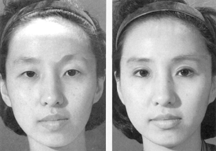
Many ask why the Oriental wants to change his face. Of course, the majority do not, but those that do give reasons which range from religious or economic to the universal desire to appear more beautiful.
--from "Oriental to Occidental," an article by Dr. D.R. Millard Jr. in Plastic & Reconstructive Surgery, 1955.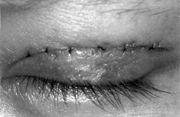
Eyes of the Storm: Surgery to modify the palpebral folds has become as common as orthodontia in many Asian contries. As it rises in popularity in this country as well, many Asian Americans are questioning whether the procedure a "white-washing" of distinct ethnic characteristics or merely a cosmetic procedure with as much significance as a perm or a haircut.
It is felt that this deorientalizing problem may well come home to the American plastic surgeon, for there have been well over 10,000 Japanese war brides as well as many post-war marriages with Korean girls. These numbers are continually mounting, for when a lonesome G.I. comes face to face with the gentle humility, artistic grace, and mysterious charm of feminine baby-san, he brings her back alive.
--"Oriental to Occidental."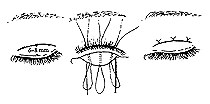
Alas, folds that were exotic in Pusan or Kyoto will become strangely foreign to Main Street of a mid-western town or under the columns of a Southern Mansion. Especially in the products of the second generation, the plastic surgeon may be called upon to help them blend in with their surroundings.
--"Oriental to Occidental"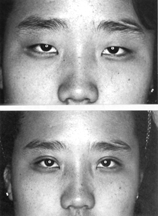
Cutting Edge: Ninety minutes under the knife and up to $3,500 is all it takes for a new set of eyelids.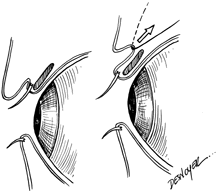
From the June 27-July 3, 1996 issue of Metro
Copyright © 1996 Metro Publishing and Virtual Valley, Inc.